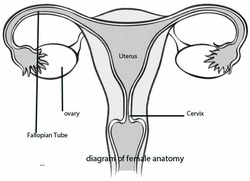
1. The angle of the arch of the pelvis
2. The descent of the uterus
3. The size of the uterus
4. The disease process being treated
The medical teaching is that most hysterectomies should be vaginal. And for a vaginal hysterectomy the angle of the arch of the pelvis should be more than 90degrees, and there should be good uterine descent. These factors allow the surgeon access to the uterus via the vagina. The ideal size of uterus for a vaginal hysterectomy is below 280g (the normal uterus weighs between 60-90g), with uteri (wombs) bigger than this it is possible to perform vaginal hysterectomy but this again requires a very skilled surgeon.
Apart from size of the uterus the shape of the uterus also plays an important part in decision-making, the broader the uterus the more difficult the surgery and if the uterus is too broad even laparoscopic hysterectomy may not be possible.
If the uterus is immobile or there is added pelvic pathology in order to visualize the pelvis a laparoscopic hysterectomy may be required.
There should be few if any reason for open abdominal hysterectomy as it is possible to remove very large uteruses either vaginally or by means of laparoscopic surgery. There are reports of uteri up to 3kg being removed laparoscopically. I have published in medical literature of techniques that can simplify laparoscopic hysterectomy for the larger uterus with fibroids.
In medical literature when comparing types of hysterectomy
1. Vaginal vs. abdominal hysterectomy
a. Shorter hospital stay
b. Faster return to normal activity
c. Fewer post operative complications
2. Vaginal vs. laparoscopic hysterectomy
a. In experienced hands no increase in operative time and no additional complications
3. Laparoscopic vs. abdominal
a. Shorter post-operative recovery and return to normal activity
b. Shorter hospital stay
c. Lower operative blood loss
d. Decreased fever
e. Fewer infections
f. Though literature suggests longer operating times and complications this was found not to be the case in expert hands. A recent study looking at 4000 women found the complication risk to be less than 1%
In the United Kingdom as in most countries the majority of hysterectomies are still performed by the open traditional method, mostly because of surgeon preference.
Before having a hysterectomy it is important to ask your doctor
1. What their commonest method of hysterectomy is
a. For normal sized uterus
b. For the large uterus
2. Are they able to carry out laparoscopic or vaginal surgery in order to avoid an open operation?








 RSS Feed
RSS Feed